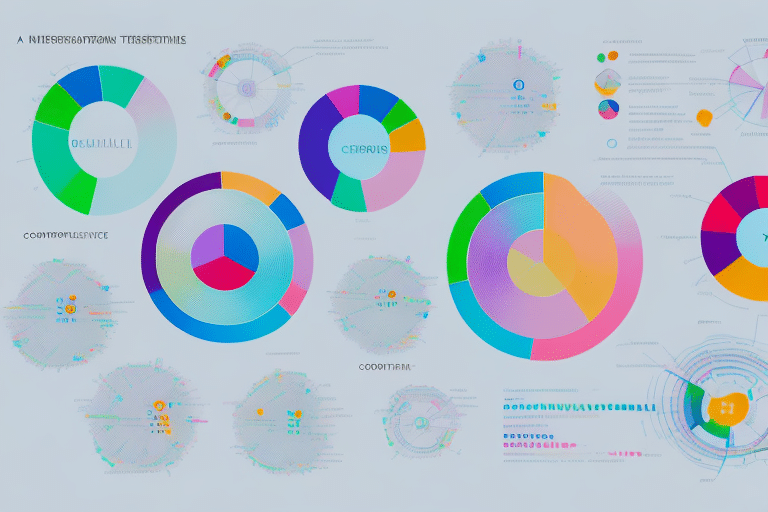Understanding Market Segmentation: What Does It Involve?
Marketing is all about identifying your target audience and finding the best ways to reach them. However, not all audiences are the same. Different demographics, personalities, and lifestyles require different approaches. This is where market segmentation comes in. In this article, we will explore the importance of market segmentation, what it involves, and how to implement it successfully. Let's dive in!
Why Market Segmentation is Important for Your Business
Market segmentation is crucial because it allows businesses to identify and target specific groups of customers with greater precision. According to a Harvard Business Review study, companies that effectively segment their markets see a significant increase in marketing ROI. By dividing a market into different segments, businesses can customize their products, messaging, and marketing strategies to reach the right people. This leads to greater customer satisfaction, increased profits, and improved brand loyalty.
Another benefit of market segmentation is that it helps businesses stay ahead of their competitors. By understanding the needs and preferences of different customer segments, businesses can develop products and services tailored to those specific groups. This can give them a competitive advantage in the market and help them stand out from competitors.
Market segmentation can also help businesses save money on marketing and advertising. By targeting specific customer segments, businesses can focus their marketing efforts on those who are most likely to be interested in their products or services. This can lead to more effective marketing campaigns and a higher return on investment (ROI).
The Definition of Market Segmentation
Market segmentation is the process of dividing a market into different groups of consumers who have distinct needs, wants, and preferences. These groups, or segments, can be based on a variety of factors, including demographics, psychographics, geography, and behavior. The goal of market segmentation is to identify the most profitable segments and develop strategies to effectively target and serve them. According to Statista, companies that use segmentation strategies are more likely to achieve higher sales and customer retention rates.
One of the benefits of market segmentation is that it allows companies to tailor their marketing efforts to specific groups of consumers. By understanding the unique needs and preferences of each segment, companies can create targeted advertising campaigns, develop products that meet specific needs, and offer promotions that resonate with each group.
Another important aspect of market segmentation is that it can help companies identify new opportunities for growth. By analyzing the characteristics of different segments, companies can identify gaps in the market and develop new products or services to meet those needs. This can help companies stay ahead of the competition and continue to grow their business over time.
The Benefits of Market Segmentation for Your Business
Market segmentation offers numerous benefits for businesses, including:
- Improved customer satisfaction and loyalty
- Increased sales and profits
- Better targeting and messaging
- Improved product development
- Reduced marketing costs
One of the key benefits of market segmentation is that it allows businesses to tailor their products and services to specific customer needs. By understanding the unique needs and preferences of different customer groups, businesses can create targeted marketing campaigns that resonate with their audience and drive sales.
Another benefit of market segmentation is that it can help businesses identify new market opportunities. By analyzing customer data and identifying gaps in the market, businesses can develop new products and services that meet the needs of previously untapped customer segments, helping to drive growth and increase market share.
Different Types of Market Segmentation
There are four main types of market segmentation:
- Demographic Segmentation
- Psychographic Segmentation
- Geographic Segmentation
- Behavioral Segmentation
Demographic Segmentation: How to Divide Your Audience by Age, Gender, Income, and More
Demographic segmentation divides a market into different groups based on variables such as age, gender, income, education level, and family size. This type of segmentation is most commonly used by marketers because it is easy to obtain this information from customers. Businesses that use demographic segmentation can tailor their products and marketing strategies specifically to each group. For example, a company that sells baby products might target families with young children, while a luxury car brand may target high-income earners.
However, it is important to note that demographic segmentation alone may not always provide a complete understanding of a customer's behavior or preferences. Other factors such as psychographic segmentation, which considers personality, values, and lifestyle, can also play a significant role in shaping consumer behavior. Therefore, businesses should consider using a combination of segmentation strategies to gain a more comprehensive understanding of their target audience.
Psychographic Segmentation: Dividing Your Audience by Personality Traits and Lifestyle Choices
Psychographic segmentation divides a market into different groups based on personality traits, values, beliefs, attitudes, interests, and lifestyles. This segmentation type seeks to answer the question, "what makes your customers tick?". By understanding the motivations and preferences of your target audience, you can better serve their unique needs. For example, a business that sells organic products may target customers who value sustainable living and environmental responsibility.
One of the benefits of psychographic segmentation is that it allows businesses to create more personalized marketing messages. By understanding the values and interests of their target audience, businesses can tailor their messaging to resonate with their customers on a deeper level. This can lead to increased brand loyalty and customer satisfaction.
However, it's important to note that psychographic segmentation can be more challenging than other types of segmentation, such as demographic or geographic segmentation. It requires a deeper understanding of your target audience and may require more resources to gather the necessary data. Additionally, it's important to avoid stereotyping or making assumptions about your audience based on their personality traits or lifestyle choices.
Geographic Segmentation: How to Divide Your Audience by Location
Geographic segmentation divides a market into different groups based on geographic location. This type of segmentation can be used to target customers based on their country, state, city, or even neighborhood. Businesses that use geographic segmentation can tailor their messaging and product offerings based on local customs, language, and culture. For example, a fast-food chain might offer different menu items in different parts of the world to better suit local tastes.
Geographic segmentation can also be used to identify areas where there is a high demand for a particular product or service. By analyzing sales data by location, businesses can identify areas where their product is popular and focus their marketing efforts on those areas. According to a Forbes article, effective geographic segmentation can lead to a 15% increase in regional sales.
Another benefit of geographic segmentation is that it allows businesses to identify areas where there is little or no competition. By targeting these areas, businesses can gain a competitive advantage and increase their market share. For example, a new restaurant might choose to open in an area where there are few dining options, making it the go-to destination for locals.
Behavioral Segmentation: Dividing Your Audience Based on Their Buying Habits and Preferences
Behavioral segmentation divides a market into different groups based on customer behavior, such as their buying habits, loyalty, and usage rate. This type of segmentation allows businesses to better target customers who are most likely to buy their products, as well as identify opportunities for cross-selling and upselling. For example, a company that sells gym equipment might target customers who have bought similar products in the past or customers who regularly attend fitness classes.
Another benefit of behavioral segmentation is that it allows businesses to tailor their marketing messages to specific customer groups. For instance, a company that sells skincare products might create different marketing campaigns for customers who have previously purchased anti-aging products versus those who have purchased acne treatments. By doing so, the company can speak directly to the needs and preferences of each group, increasing the likelihood of a sale.
However, it's important to note that behavioral segmentation requires businesses to collect and analyze customer data. This can be a time-consuming and costly process, but it's essential for effective segmentation. Additionally, businesses must ensure that they are using the data ethically and in compliance with privacy laws and regulations, such as the FTC Privacy Laws.
The Process of Conducting Market Research for Effective Market Segmentation
Effective market segmentation requires careful research and analysis. The process typically involves the following steps:
- Define the Problem: Clearly identify the business challenge or opportunity you aim to address through segmentation.
- Conduct Secondary Research: Gather existing data from sources like industry reports, academic papers, and market analysis.
- Gather Primary Data: Collect new data directly from your target audience through surveys, interviews, or focus groups.
- Analyze the Data: Examine the data to identify patterns and distinct customer groups.
- Identify Segments: Define the specific segments based on the analysis.
- Develop Marketing Strategies: Create tailored marketing plans for each identified segment.
How to Implement a Successful Market Segmentation Strategy
Implementing a successful market segmentation strategy requires a clear understanding of your target audience, as well as a solid marketing plan. Here are some key steps to follow:
- Identify Your Target Market: Determine which segments are most valuable and align with your business goals.
- Select the Appropriate Segmentation Criteria: Choose the factors (demographic, psychographic, geographic, behavioral) that best define your segments.
- Analyze the Segmentation Results: Assess the attractiveness and feasibility of each segment.
- Develop Marketing Strategies for Each Segment: Create customized marketing campaigns tailored to each segment's needs and preferences.
- Test and Refine Your Strategies: Continuously monitor the effectiveness of your strategies and make necessary adjustments based on feedback and performance metrics.
Common Mistakes to Avoid When Implementing a Market Segmentation Strategy
While market segmentation can be a powerful tool for businesses, there are several common mistakes to avoid:
- Not Gathering Enough Data: Insufficient data can lead to inaccurate segmentation and misguided strategies.
- Using Outdated Data: Market conditions and consumer behaviors change over time. Ensure your data is current to maintain relevance.
- Over-Segmentation: Creating too many segments can dilute your marketing efforts and make it difficult to manage resources effectively.
- Under-Segmentation: Failing to segment adequately can result in generic marketing that doesn't effectively reach any particular group.
- Ignoring Profitable Segments: Overlooking high-value segments can mean missing out on significant revenue opportunities.
Measuring the Success of Your Market Segmentation Strategy
Measuring the success of your market segmentation strategy is essential to ensure that you are achieving your goals. Some common metrics to consider include:
- Sales Revenue: Track the increase in sales within each targeted segment.
- Market Share: Measure your business's share of the market compared to competitors.
- Customer Satisfaction: Use surveys and feedback to assess how satisfied each segment is with your products or services.
- Customer Retention: Monitor the rate at which customers from each segment continue to do business with you.
- Marketing ROI: Calculate the return on investment for marketing campaigns targeted at each segment.
The Role of Technology in Enhancing Market Segmentation Strategies
Technology plays a significant role in enhancing market segmentation strategies. Advances in data analytics, social media, and artificial intelligence have made it possible for businesses to gather more accurate data about their customers and use that data to improve their marketing efforts. For example, businesses can use social media analytics to target specific audience segments based on their interests and behaviors, or use predictive analytics to anticipate future customer needs.
Tools like Tableau and Salesforce Einstein provide advanced capabilities for analyzing customer data and identifying meaningful segments. Additionally, machine learning algorithms can process large datasets to uncover hidden patterns and insights that might not be immediately apparent through traditional analysis.
Examples of Successful Businesses That Use Effective Market Segmentation
Many successful businesses use market segmentation to great effect. For example:
- Apple has successfully targeted high-income professionals and tech enthusiasts with its premium products and sleek design, positioning itself as a leader in innovation and quality.
- Nike has segmented its market by targeting athletes and fitness enthusiasts with its high-performance products and motivating messages, fostering a strong brand community.
- Starbucks has targeted a wide range of customers by offering a customizable menu and a comfortable atmosphere in its coffee shops, catering to both casual drinkers and dedicated coffee aficionados.
Market segmentation is an essential tool for businesses looking to improve their marketing efforts and better serve their customers. By dividing a market into distinct segments and developing strategies specific to each segment, businesses can increase customer satisfaction, sales, and profits. Remember to conduct thorough research, analyze your results carefully, and continually refine your strategies to achieve the best results.




















